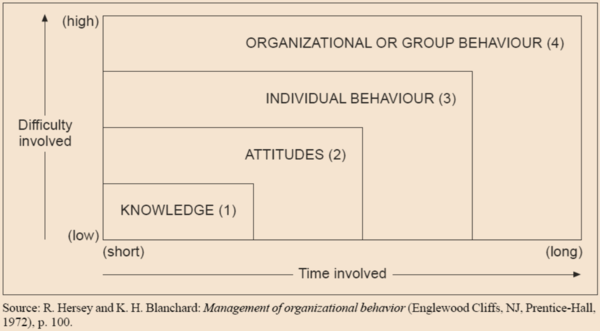 
 字體:小 中 大
字體:小 中 大 |
|
|
|
| 2014/02/26 11:23:38瀏覽341|回應1|推薦0 | |
Change in people The human dimension of organizational change is a fundamental one. For it is the behaviour of the people in the organization – its managerial and technical staff, and other workers – that ultimately determines what organizational changes can be made and what real benefits will be drawn from them. Business firms and other organizations are human systems above all. People must understand, and be willing and able to implement, changes that at first glance may appear purely technological or structural, and an exclusive province of higher management, but which will affect the working conditions, interests and satisfaction of many other people. In coping with organizational change, people have to change, too: they must acquire new knowledge, absorb information, tackle new tasks, upgrade their skills, give up what they would prefer to preserve and, very often, modify their work habits, values and attitudes to the way of doing things in the organization. It is important to recognize that this requirement relates to everyone in an organization, starting with the most senior manager. Those who want their subordinates and colleagues to change must be prepared to assess and change their own behaviour, work methods and attitudes. This is a golden rule of organizational change. But how do people change? What internal processes bring about behavioural change? Many attempts have been made to describe the change process by means of models, but none of these descriptions has been fully satisfactory. Different people change in different ways, and every person has particular features that influence his or her willingness and ability to change. The influence of the culture in which a person has grown up and lived is paramount, Auseful concept of change in people was developed by Kurt Lewin.1 It is a three-stage sequential model, whose stages are referred to as “unfreezing”,“changing” and “refreezing”.Unfreezing postulates a somewhat unsettling situation as it is assumed that a certain amount of anxiety or dissatisfaction is called for – there must be a need to search for new information if learning is to take place. Conditions that enhance the unfreezing process usually include a more than normal amount of tension leading to a noticeable need for change – for example, an absence of sources of information; removal of usual contacts and accustomed routines; and a lowering of self-esteem among people. In some instances, these preconditions for change are present before the consultant arrives on the scene. In other instances, the need for change is not perceived and has to be explained if unfreezing is to occur – for example, by making it clear what will happen if theorganization or the person does not change. Changing, or moving towards change, is the central stage of the model, in which both management and employees start practising new relationships, methods and behaviours. The subprocesses of changing involve two elements: – identification, where the people concerned test out the proposed change,following the external motives presented to them (e.g. by management or a consultant); – internalization, where individuals translate the general objectives and principles of change into specific personal goals and rules; this process may be quite difficult, usually requiring a considerable effort by the person concerned, and a great deal of patience, creativity and imagination on the part of the consultant in assisting the change, to convert the external (general) motives to internal (specific and personal) motives for accepting the change proposed. Refreezing occurs when the person concerned verifies change through experience. The subprocesses involved require a conducive and supportive environment (e.g. approval by responsible management) and are usually accompanied by a heightening of self-esteem as a result of a sense of achievement derived from accomplishing a task. During the initial phases of the refreezing stage it is recommended that the required behaviour should be continuously reinforced by means of rewards, praise, and so on, to encourage and accelerate the learning process. In the later phases, intermittent or spaced reinforcement will help to prevent extinction of the newly acquired behavioural patterns. Eventually the new behaviour and attitudes are either internalized, or rejected and abandoned. Change in a particular person takes place at several levels: at the knowledge level (information about change, understanding its rationale), the attitudes level (accepting the need for change and a particular measure of change both rationally and emotionally) and the behavioural level (acting in support of effective implementation of change). Figure 4.1 shows four levels of change: (1) in knowledge, (2) in attitude, (3) in individual behaviour, and (4) in organizational or group behaviour. The relative levels of difficulty and time relationship are alsoindicated in the diagram. This, however, does not imply that change must always start at the lowest level and proceed to higher levels (see box 4.1). Change in individuals within an organization is also directly affected bychanges in the external environment. This environment is not something that“starts behind the factory gate”, but permeates the organization. People “bring the environment with them” and it stays with them when they come to work. Thus, changes occurring in the environment of an organization may facilitate or hamper change in people working within the organization. A frequent problem is that of individuals who are simultaneously exposed to so much change and stress, at work and in their social and family life, that they are not able to cope and so break down. On the other hand, many environmental changes, such as an increased penetration of new information and communication technologies into all areas of human life, greatly facilitate the changes that have to be made within particular organizations. 整理至: management consulting |
|
| ( 知識學習|商業管理 ) |










